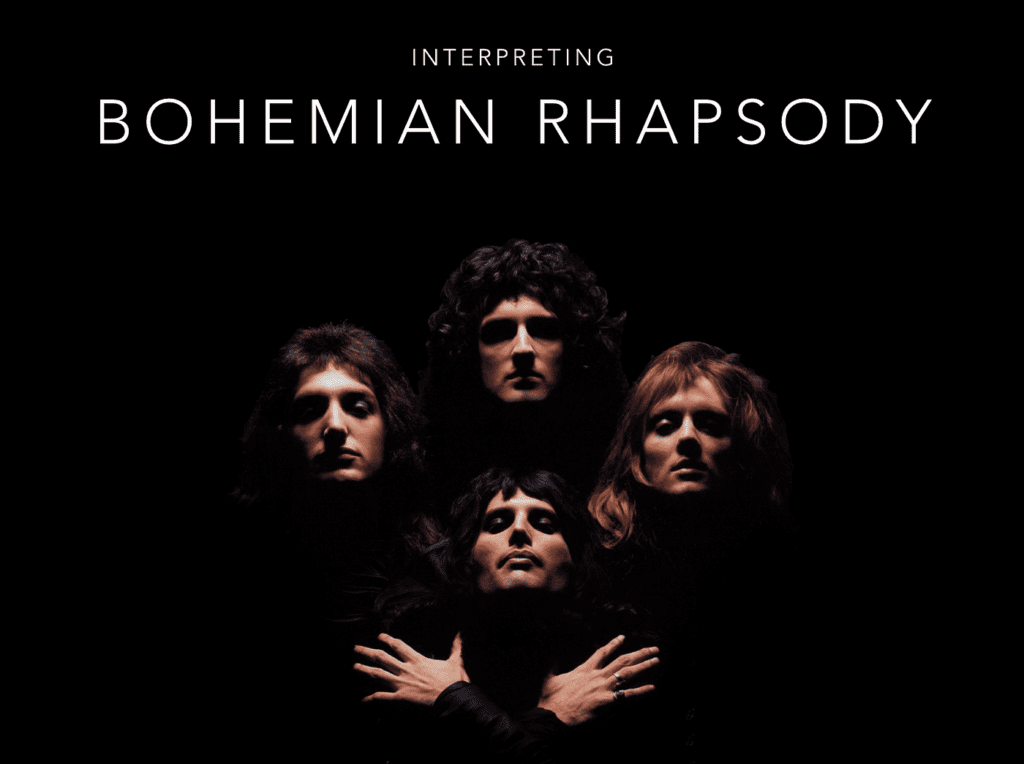Queen’s “Bohemian Rhapsody” is a song that has puzzled and captivated audiences for decades. Its intricate structure, dramatic shifts, and enigmatic lyrics make it one of rock music’s most iconic tracks. Written by Freddie Mercury in 1975, the song blends different musical styles and creates a narrative open to interpretation. But what is the meaning behind this legendary anthem?

Song Meaning Analysis
The song can be divided into several parts, each with its own distinct feel, reflecting the inner turmoil of the narrator. At its core, “Bohemian Rhapsody” is often seen as an exploration of guilt, fate, and existential crisis.
Intro: “Is this the real life? Is this just fantasy?”
The song opens with a question, immediately introducing a surreal and dreamlike atmosphere. The soft harmonies create a sense of doubt and confusion, pulling listeners into the narrator’s internal conflict. This could symbolize feelings of disbelief or denial, perhaps about a life-altering event.
Ballad Section: “Mama, just killed a man…”
This section reveals a dramatic shift in tone. The narrator confesses to murder, expressing remorse to his mother. Some have speculated that this reflects Mercury’s personal struggles with identity and guilt. The symbolic “killing” may represent the death of one part of the self or the breaking of societal norms. The plaintive piano and Mercury’s emotional delivery highlight the deep sorrow and regret.
Opera Section: “Scaramouche, Scaramouche, will you do the Fandango?”
The opera segment is full of whimsical and cryptic references. “Scaramouche” and “Galileo” may represent Mercury’s love for theater and science. The dramatic shift to this playful and chaotic section symbolizes an inner conflict, almost like a mental breakdown or the workings of the narrator’s conscience. The use of operatic motifs and shifting time signatures reflects the chaos of the situation, as if judgment is looming.
Hard Rock Section: “So you think you can stone me and spit in my eye?”
This segment bursts into an aggressive rock sound, marking a defiant turn. The narrator seems to be challenging fate or those who have wronged him. The intensity of the guitar and drums symbolizes anger and rebellion, a striking contrast to the previous sections. This moment could signify a refusal to succumb to guilt or external pressure.
Outro: “Nothing really matters…”
The song ends on a soft and melancholy note, with Mercury’s voice delivering the haunting line, “Nothing really matters.” This nihilistic conclusion may represent acceptance or resignation. The stripped-down instrumentation reflects the emotional exhaustion and surrender, a calm after the storm of emotions.
Historical Context
“Bohemian Rhapsody” was released in 1975 on the album A Night at the Opera, a time when rock music was evolving to incorporate more experimental sounds. Freddie Mercury, a bold and creative artist, pushed the boundaries of traditional song structures. The use of operatic elements and multi-part harmonies was groundbreaking, blurring the lines between rock, opera, and classical music.
Key Themes and Symbolism
The song explores themes of guilt, redemption, and existential crisis. The metaphoric use of characters like Scaramouche and Beelzebub serves as representations of inner conflict and judgment. These theatrical personas enhance the dramatic tension in the lyrics, allowing Mercury to express a wide range of emotions through metaphorical storytelling.
Critical Reception and Cultural Impact
“Bohemian Rhapsody” was a commercial and critical success, topping the UK charts for nine weeks and becoming one of the best-selling singles of all time. It received multiple awards and has been praised for its originality and ambition. The song gained renewed popularity after its inclusion in the 1992 movie Wayne’s World, and again after the release of the 2018 biopic Bohemian Rhapsody, which portrayed Mercury’s life.
Critics have lauded the song for its boldness and uniqueness. Rolling Stone called it “a once-in-a-lifetime fusion of opera, rock, and theatricality.” Its enduring popularity is a testament to its emotional depth and innovative musical composition.
Conclusion
Queen’s “Bohemian Rhapsody” remains a monumental achievement in music history. Its complex lyrics, dynamic shifts in style, and groundbreaking structure continue to inspire new generations of listeners. Whether interpreted as a personal confession or a surreal narrative, the song’s ability to evoke deep emotions is undeniable.
Sources:
- Queen, A Night at the Opera, EMI, 1975.
- “Bohemian Rhapsody,” Rolling Stone, https://www.rollingstone.com/.
- “Freddie Mercury Interview,” BBC Archives, 1975.



